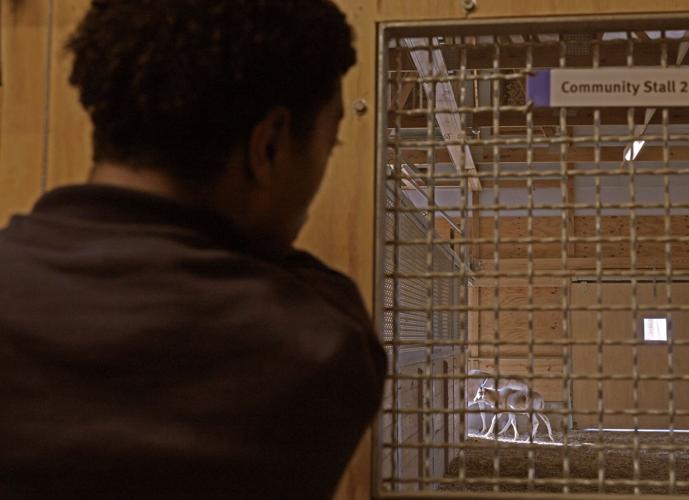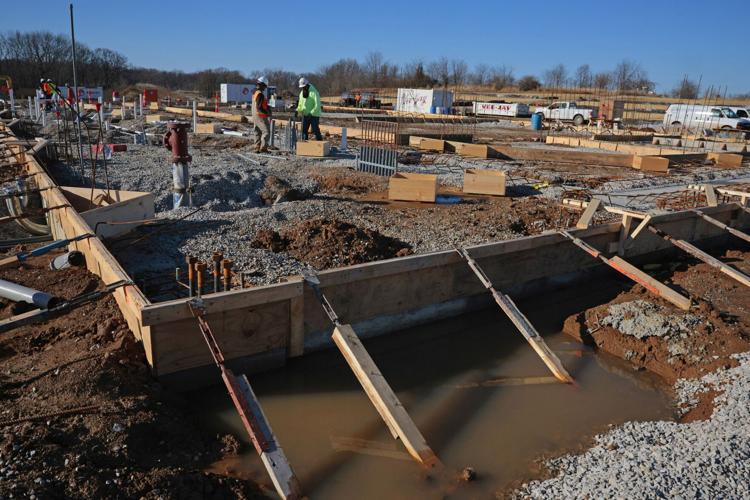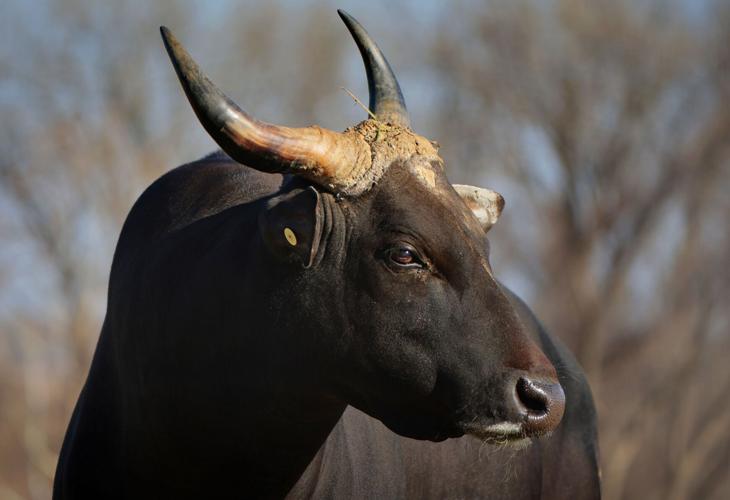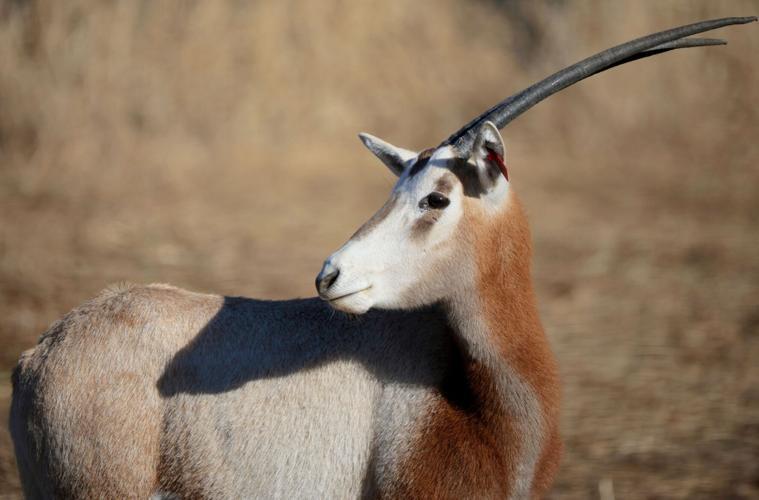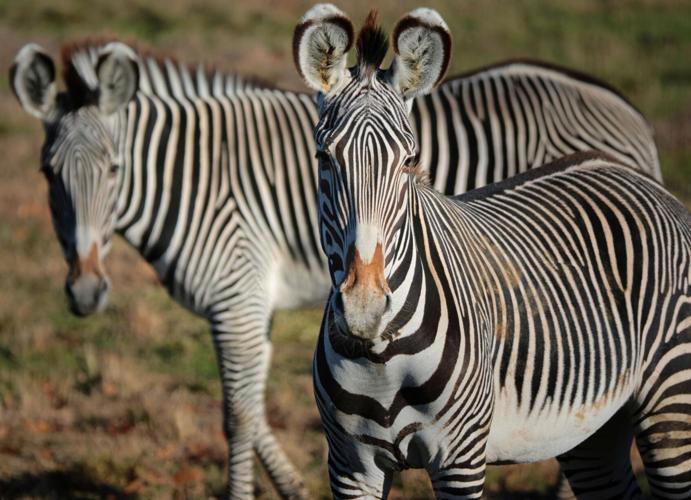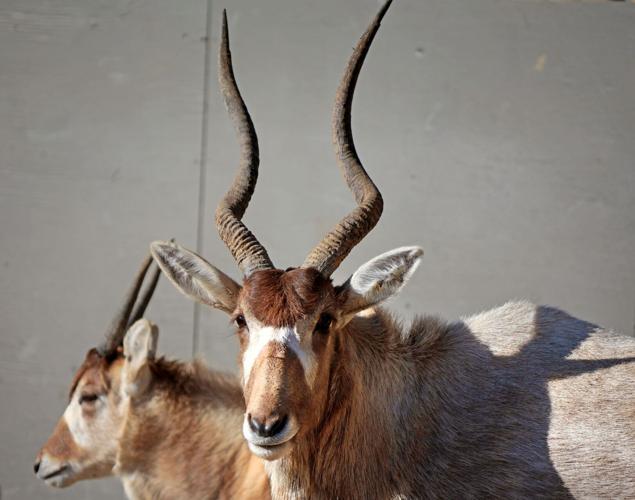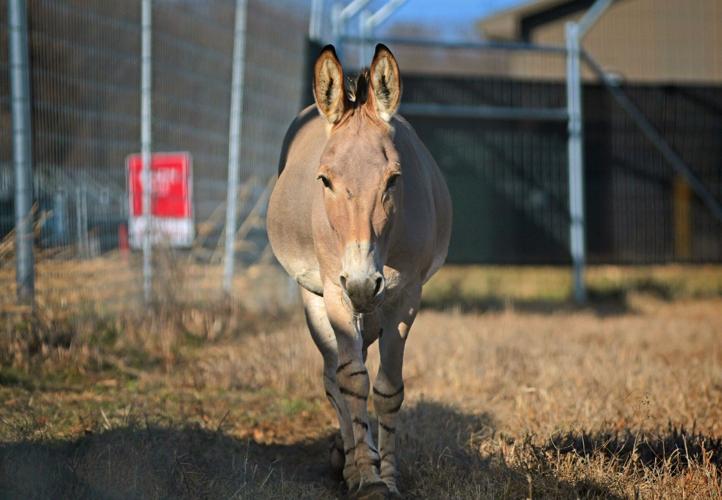SPANISH LAKE — Construction of a safari-style zoo in north St. Louis County is well underway, with money from a special sales tax flowing in along with new animals.
Martha Fischer, general curator at the facility, called WildCare Park, answered questions about progress there.
And yes, it’s still expected to open in 2027.

Jackson Tucker, a keeper at the St. Louis Zoo’s WildCare Park, coaxes a herd of addax to move to another pasture on Monday, Dec. 16, 2024, in the conservation and animal science area of the Spanish Lake property that focuses on the breeding of animals. There will also be a safari-type animal experience for park visitors.
How’s construction going?

Builders construct the beginnings of a large giraffe barn on Monday, Dec. 16, 2024, in the area for the Savanna Safari, one of two vehicle safaris that will be offered at WildCare Park. The Spanish Lake property that the St. Louis Zoo is converting will also have a section focused on the conservation and breeding of animals.
Crews at WildCare Park built seven barns this year. They’re working on finishing two more. One barn, at more than 38 feet tall, will house a giraffe. The other, made of thick concrete, will be home to rhinoceroses.
Crews also renovated an office building at the site, formerly home to the United Association of Plumbers and Pipefitters Local 562. The building, which the union used for its administrative offices, is now called Conservation Headquarters. The board room overlooks a field of zebras.
People are also reading…
The zoo is also preserving a circular building the zoo considers architecturally significant. It was formerly used as a clubhouse for the Emerald Greens Golf Course. The zoo plans to use it for events along with a new event center the zoo will build.
How much has WildCare Park cost so far?

Bruno, a banteng male, is seen Monday, Dec. 16, 2024, at the St. Louis Zoo’s WildCare Park.
The zoo has spent $67.7 million in construction costs and $8.7 million in operation costs at WildCare Park. Government bonds approved by Missouri officials pay for construction.
A combination of general zoo funds and sales tax revenue pay for operations:
In 2018, St. Louis County voters passed a sales tax to fund WildCare Park. The sales tax of one-eighth of 1% adds a penny to an $8 purchase in the county and is projected to raise more than $20 million a year.
The zoo began receiving sales tax revenue in May 2019. Through November, it has received $130.3 million. Anyone who shops in St. Louis County pays the tax. County residents get free admission to the park.
How many animals are there at the park now?

A scimitar-horned oryx male is photographed on Monday, Dec. 16, 2024, in the future Savanna Safari area of WildCare Park. It is one of two vehicle safaris that will be offered at he Spanish Lake property that the St. Louis Zoo is converting. It will also contain conservation and animal science center there.
WildCare Park has 34 animals now, double the count in June: 14 addax, five banteng, six Grévy’s zebra, one Somali wild ass and eight scimitar-horned oryx, which are new to the zoo.
Until late last year, the oryx was considered “extinct in the wild.” But thanks to efforts by the zoo and other conservation organizations, the species was downlisted to “endangered” about a year ago.
More are on the way. When the park opens in 2027, there will be at least 250 adult animals living there including giraffe, rhinos and kangaroos.
How do the animals stay warm in the winter?
The zoo chose species that can withstand Missouri’s seasonal swings. But animals have access to barns where they can warm up, cool off or find shelter from bad weather.
How many employees work at WildCare Park now?
Aside from contractors, 23 full-time and 11 part-time.
How are the animals adapting to their new home?

TOP: Grevy’s zebras are photographed on Monday, Dec. 16, 2024, at the St. Louis Zoo’s WildCare Park. BOTTOM: Bruno, a banteng male, is seen Monday, Dec. 16, 2024, at the St. Louis Zoo’s WildCare Park.
“The herds at WildCare Park are settling in extremely well,” said Fischer, the park’s general curator. Three animals, all endangered species, were born at the park this year: two addax, Atlas and Poppy, and one Grevy’s Zebra, Roxie.
Roxie, the first animal born there, is doing well, zoo CEO Dwight Scott said in a zoo commission meeting in December. She’s almost as big as the adult Grévy’s zebras, the most endangered species of zebras in the world.
Only about 2,500 Grévy’s zebras remain in the wild, with some in Ethiopia and most in Kenya. Habitat loss, food competition with livestock and drought threaten their survival.
The zoo, under the leadership of general curator Fischer, started a Grévy’s zebras conservation program 20 years ago, Scott said. The zoo seeks to create a genetically healthy population of the zebras in North American zoos and tries, whenever possible, to reintroduce the animals to their home range.
“This is what we call fence to field,” Scott said.
Roxie, a Grevy's zebra, was the first animal born at the St. Louis Zoo's WildCare Park on April 16, 2024.
What about plant life at the park?
Every plant at WildCare Park will be a native plant friendly to the park’s herds of grazing animals as well as native wildlife. But turning the park into a native landscape was a heavy lift.
Before the zoo bought the park land in 2018, the plumbers and pipefitters union used it as a picnic and relaxation space for families, and members and the public could also golf at the Emerald Greens Golf Course.
The zoo turned 260 acres of golf turf into a native grassland, removing honeysuckle and other invasive plants — plus hundreds, if not thousands, of abandoned golf balls.

An adult addax stays close to a fawn on Monday, Dec. 16, 2024, outside a barn in the conservation and animal science portion of the Spanish Lake property that the St. Louis Zoo is converting to WildCare Park. The other portion will be a safari-type animal experience for visitors.

Abai, a male Somali wild ass is photographed on Monday, Dec. 16, 2024, in the conservation and animal science portion of the Spanish Lake property that the St. Louis Zoo is converting to WildCare Park. The other portion will be a safari-type animal experience for visitors.
St. Louis Zoo WildCare Park Director Sabarras George talks about WildCare Park in St. Louis County. The park is scheduled to open in 2027.









